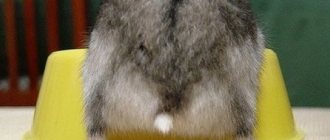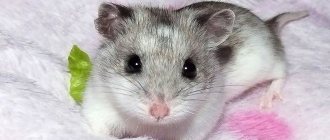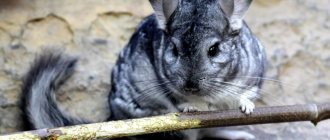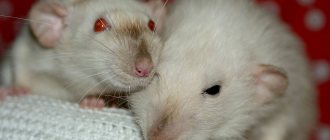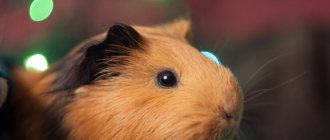Rodents can suffer from various types of diseases. Often their causes are unknown. Unfortunately, according to statistics, every tenth mature hamster has a tumor or neoplasm. It is very disappointing to discover this problem in your pet. But perhaps your pet will be healthy. We recommend that you immediately check your pet, the most vulnerable areas on the body: neck, stomach, paw, back, side, and less often on the butt. These are the ones that need to be checked first. Tumors can be painful or painless, hard or soft.
The most common signs of illness or injury in hamsters
Hamsters usually exhibit one or more of these signs when coping with illness or injury.
loss of appetite inactivity huddling in a corner a disheveled or unkempt coat sneezing, wheezing and/or discharge from the nose or eyes wetness around the tail diarrhea hair loss (often a sign of parasites or allergies)
If your hamster is sick or injured, keep him warm and have him take some food or water (using a dropper if necessary) until the veterinarian arrives.
Diseases similar to neoplasms
If you find a tumor in your pet, it may be:
- inflammatory process in the lymph node;
- abscess;
- benign or malignant neoplasm.
Sometimes an infection enters the animal’s body and the lymph nodes become involved. When one of them is under increased load, it increases. In advanced cases, an abscess begins.
In addition to damage to the lymph nodes, abscesses can occur as a result of injuries that violate the integrity of the skin. For example, when pricked with a sharp object and infection develops in the wound. An abscess is a purulent cavity that occurs as a result of inflammation in the tissues and the addition of pyogenic microflora. An abscess is characterized by redness, swelling, and tension of the skin. When palpating the abscess, fluctuation (fluid transfusion) is clearly felt. The formation is dense to the touch and there is pain. It is not removed, but opened and disinfected.
Hamster abscesses
Abscesses are pockets of infection that can form due to minor breaks in the skin. Pus accumulates under the skin, sometimes forming a large lump that sometimes begins to drain on its own.
Abscesses can form from cuts or scrapes in the skin or in the cheek pouches if an abrasive food material causes scratches on the lining of the mouth.
If your hamster constantly looks like he has food in his cheek pouches, this may indicate an abscess or damaged cheek pouch. Abscesses require the attention of a veterinarian for drainage, irrigation, and treatment with antibiotics.
Care
If your hamster has an abscess under its skin or in its cheek pouch, it will need to be drained first. Your veterinarian may have already done this as part of diagnostic testing to determine the contents of the bolus, or he may need to sedate or anesthetize your hamster to complete this task.
The abscess may then need to be flushed with saline and antibacterial agents, and you will usually be given antibiotics to administer at home. The exact treatment may vary depending on the location and severity of the abscess. Sometimes it is possible to obtain a culture of the type of bacteria present in the abscess to determine the best type of antibiotics for your hamster.
Respiratory infections in hamsters
Hamsters can get respiratory infections that can lead to pneumonia. Signs of a respiratory infection include sneezing, discharge from the eyes or nose, wheezing, and difficulty breathing.
Occasional sneezing is not too concerning, but if there is loss of appetite, decreased activity, wheezing or difficulty breathing, contact your veterinarian immediately.
Warning
Drafts and sudden changes in temperature can put your hamster at risk of developing a respiratory infection, and some types of bedding (such as cedar and pine) can irritate the respiratory tract, which can also lead to infection.
Treatment of phlegmon
Treatment of phlegmon is surgical - opening the abscess, excision of necrotic tissue (see photo below).
In the photo, the phlegmon is opened, the Achilles tendon is visible at the bottom of the wound.
After opening the abscess, the wound is cleaned, inflammation subsides, and wound healing processes begin.
In the photo, the wound has cleared and is beginning to heal.
In the complex treatment of phlegmon, antibiotics, immunocorrectors, physiotherapy, etc. are also used.
The photo below shows phlegmon of the left forearm, which developed from a boil.
In the photo below, the same phlegmon is opened, the wound is cleaned.
The photo below shows the same wound, almost healed.
The wound has healed.
The photo below shows advanced phlegmon of the thigh. The duration of the disease is 2 weeks.
The patient refused hospitalization, so treatment of phlegmon had to be carried out in a clinic. In the photo below - the same phlegmon 7 days after the operation - the wound has cleared and is granulating.
After cleaning the wound, secondary sutures were applied (photo below).
Wet tail in hamsters
Wet tail, also called proliferative ileitis and regional enteritis, is a highly contagious disease and most often occurs in recently weaned hamsters. The cause is unclear, but a bacteria called Campylobacter jejuni may be involved, and in some cases the disease is associated with stress, overcrowding and changes in diet.
Affected hamsters can die very quickly, showing signs such as diarrhea (causing wetness around the tail), lethargy, loss of appetite and ruffled fur. Not all hamsters with diarrhea have a wet tail, but if your hamster has any of these symptoms, you should seek help from your veterinarian.
Swollen paws
If a tumor appears on the paw, your rodent most likely has a closed fracture. To make an accurate diagnosis, it is necessary to take an x-ray. In veterinary practice, treatment of such pathology is based on providing the rodent with complete rest. Plaster application and surgery are not performed in this case.
If a hamster's paw is swollen, it is placed in a separate cage. To prevent further injury to the affected limb, remove the old bedding and make a floor of napkins or toilet paper instead.
Proper nutrition will also be important in order to speed up the healing of the fracture. If the fracture is open and there is suppuration, it is necessary to carry out the procedure of washing the limb with an antiseptic every day.
Sometimes swollen paws in adults are a consequence of cancer. In veterinary medicine this is called osteosarcoma. This disease cannot be cured. It progresses quite quickly, affecting the entire body, as a result of which the hamster dies.
Diarrhea in hamsters
A number of infections can cause diarrhea, including but not limited to wet tail, dietary changes, intestinal parasites, and antibiotic treatment. Overfeeding vegetables and other fresh foods is a common cause of diarrhea, but there is usually no loss of appetite or decreased activity.
Dehydration is a serious problem any time your hamster has diarrhea, so make sure he is still drinking water if this happens.
If you have diarrhea, avoid eating fresh foods for a few days and only resume offering them once the diarrhea has completely resolved. Then slowly reintroduce fresh foods so your hamster can slowly adjust to the changes in diet.
If lethargy or lack of water occurs along with diarrhea, you should seek help from your veterinarian.
Treatment and prevention of tumors in hamsters
If the tumor turns out to be benign, then you can resort to preventive procedures. But if the tumor is malignant, surgical intervention is required. Most often this is amputation of limbs. If an inflammatory process has formed on the pet’s body, then treatment consists of taking antibiotics.
In cases where a pet develops oncology in soft tissues, the best way out of the situation is euthanasia. Since such a disease will spread to healthy tissues and, sooner or later, the hamster will die.
To avoid tumors and neoplasms on your pet’s body, you should follow some preventive actions:
- Change the bedding and wash the cage regularly.
- Choose high-quality food for your hamster, without nitrates and preservatives.
- Monitor your pet's emotional state.
- Make sure that toys and accessories have no sharp corners.
- Do not take your pet outside to avoid catching a cold.
- Equip the cage with a wheel or a maze.
Skin diseases in hamsters
Hamsters can be infested with a variety of skin and fur mites, which can be diagnosed by a skin scraping performed by a veterinarian. Ringworm, fungal infection, allergic dermatitis and skin infections can also occur on the skin and require treatment by a veterinarian.
Hair loss is not unusual and may be seasonal or occur in older hamsters. But if the skin develops flaking, redness or any lesions, or if your hamster itches more than usual, you should contact your veterinarian.
Hamsters do have scent glands on their sides, which can be dark and sometimes alarming to owners. They occur on both sides of the body and should not cause irritation or bother the hamster. Cedar bedding can also cause skin irritation and should be avoided.
A tumor is not always oncology
The tumor in hamsters has a different character. What to do if hamsters have a tumor worries many. First of all, tumors can be divided into:
- benign;
- malignant.
Malignant formations on the body of a hamster lead to death. Medicine is still unable to defeat cancer cells. Mutated cells penetrate healthy ones and begin to change their code. This leads to a complete change in DNA, which kills the animal's body.
In addition to all this, the hamster suffers from rabies. Or at least it might hurt. This disease is as dangerous for a hamster as a tumor.
Benign tumors can arise as a result of malfunctions in the diet, injuries or malfunctions of the animal itself. Such tumors are easy to get rid of. They do not grow into the hamster’s body and do not damage neighboring tissues; they are easily removed through surgery.
Sometimes tumors arise due to a hormonal imbalance in the animal. These tumors are more difficult to get rid of.
Lumps on the abdomen
Sometimes neoplasms in rodents appear on the abdomen. In most cases, a tumor on the abdomen appears in mature females in the area of the mammary glands and can be either benign or malignant. Since this growth is not internal, it can be removed.
When examining males, it is necessary to remember that their marker glands are located on the abdomen, which are often confused with a sore. In Djungarian hamsters, the gland is yellowish in color and covered with a crust. Syrians have two of them, they are placed in front of the hind legs symmetrically on both sides and resemble an oval black bald spot.
This is not swelling in the hamster’s abdomen, but an anatomical formation and does not need to be treated. But in order to avoid inflammation or neoplasm in the area of the scent gland, an examination is necessary.
Prevention
Most diseases occur due to unbalanced nutrition and uncomfortable living conditions. You should feed the hamster with ready-made food mixture from the store, adding a little carrots or cauliflower. The animal will happily eat human food - bread or cheese, but such treats most often do harm, undermine the immune system and become the cause of many diseases, including the tumor process. The rodent should not be bathed. He can't stand drafts.
Satiety and fun are the best prevention
Lump on cheek
If an animal has a bump on its cheek that looks like gumboil, this indicates inflammation of the oral cavity, which occurs due to clogging or damage to the cheek pouches with hard, inappropriate food. In the resulting wounds, microbes multiply and provoke severe inflammation, causing swelling on the cheek. The problem is eliminated by visiting a veterinary clinic, where the wounds will be cleaned, disinfected and treated with antibiotics.
If there is a lump on the cheek in the form of a lump under the eye, it is necessary to check the bite, in addition to the cheek pouches. If the teeth are not ground down, malocclusion develops.


